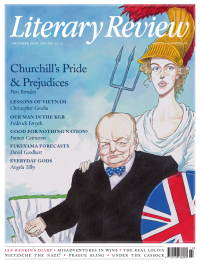Angela Tilby
All in Good Faith
Living with the Gods: On Beliefs and Peoples
By Neil MacGregor
Allen Lane 488pp £30
Neil MacGregor is one of the most prominent art historians of our age. He has not only proved to be a formidable museum director (he ran the National Gallery for fifteen years and the British Museum for thirteen); he is also a charismatic communicator. Only someone with a truly quirky imagination could have realised that a history of the world told through the stories of a hundred objects would work just fine on radio; that the absence of images and the opportunity for uncluttered verbal description would spark curiosity and engagement more effectively than a standard museum visit. The same technique lies behind this book, which is based on another radio series, Living with the Gods.
MacGregor has always had an interest in religion and has made no secret of his Christian faith. But this book takes a view of religion that some may find surprising. Based on his wide knowledge of religious artefacts from all over the world, it presents religion not as a private matter, but as an essentially social and political phenomenon. The ‘objects’ he describes, many of which can be found in the British Museum, are expressions of vital practices designed to establish harmony with the divine realm, with nature and within the community as a whole. These objects show that the function of religion is to bind the individual into a narrative that includes the dead and the unborn. This will be hard for many to understand in our post-Enlightenment world.
The objects that trigger MacGregor’s reflections begin with the extraordinary Ice Age Lion Man, an ivory figurine from Ulm in southwest Germany that was discovered in fragments in 1939. This, MacGregor says, is the oldest example of ‘the human mind giving physical form to something which can never

Sign Up to our newsletter
Receive free articles, highlights from the archive, news, details of prizes, and much more.@Lit_Review
Follow Literary Review on Twitter
Twitter Feed
Literary Review is seeking an editorial intern.
Though Jean-Michel Basquiat was a sensation in his lifetime, it was thirty years after his death that one of his pieces fetched a record price of $110.5 million.
Stephen Smith explores the artist's starry afterlife.
Stephen Smith - Paint Fast, Die Young
Stephen Smith: Paint Fast, Die Young - Jean-Michel Basquiat: The Making of an Icon by Doug Woodham
literaryreview.co.uk
15th-century news transmission was a slow business, reliant on horses and ships. As the centuries passed, though, mass newspapers and faster transport sped things up.
John Adamson examines how this evolution changed Europe.
John Adamson - Hold the Front Page
John Adamson: Hold the Front Page - The Great Exchange: Making the News in Early Modern Europe by Joad Raymond Wren
literaryreview.co.uk